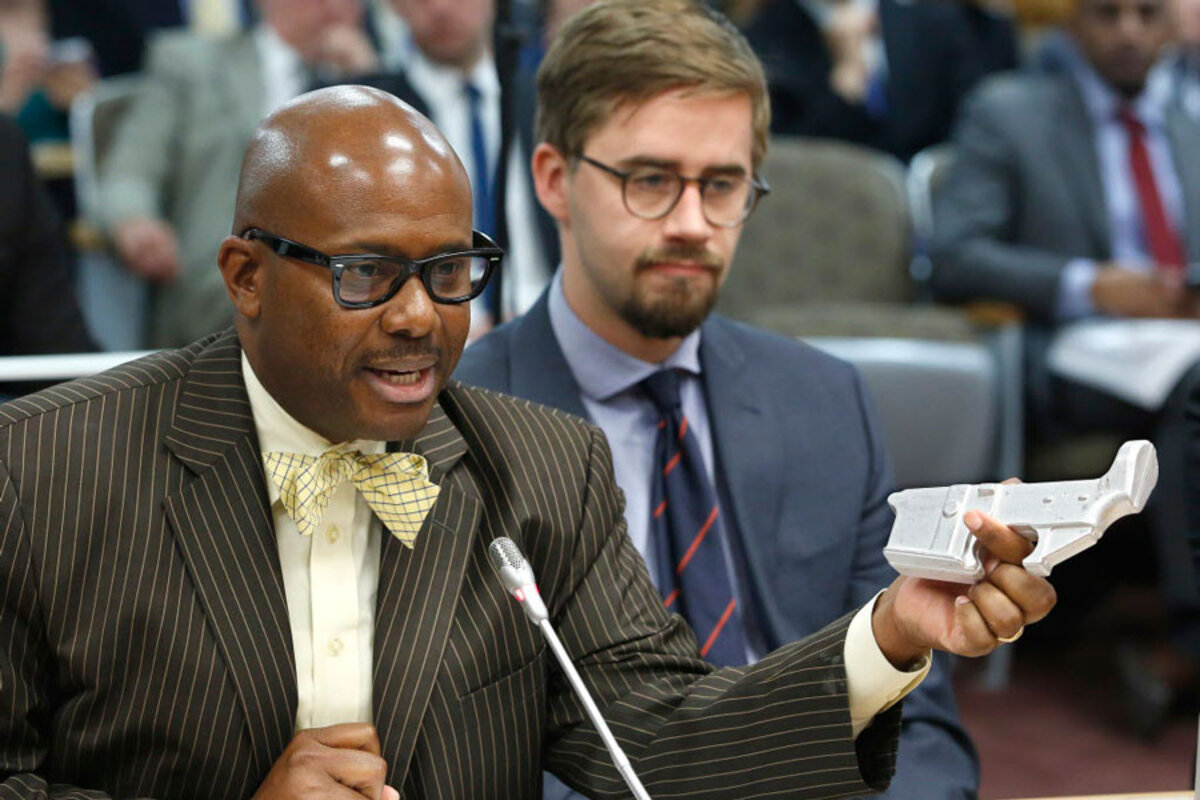Can states separate politics from gun policy? California aims to try.
Loading...
| Los Angeles
Is it possible to separate politics from gun policy in the United States? California lawmakers say they are trying to do just that.
Days before Democrats and Republicans in Congress traded verbal blows over four failed gun control amendments in the wake of the mass shooting in Orlando, Fla., the California Legislature to allot $5 million over five years to establish a state research center on gun violence.
If the bill is signed by Gov. Jerry Brown (D), the center would become the first such publicly-chartered institute in the nation, says Garen Wintemute, director of the Violence Prevention Research Program at the University of California, Davis.
The goal is to use science to “help policy makers get past the politics,” said Sen. Lois Wolk (D) of Davis, the bill’s sponsor, in a statement. Such an effort, Professor Wintemute and others say, could help in the crafting of policies that both protect Second Amendment rights and reduce gun violence – and suggests that here, at least, bipartisan political will exists to examine the relationship between firearms and violence.
Despite the national stalemate around gun violence research, the California center, along with other efforts to promote unbiased information on the issue, could play a role in emphasizing the middle ground. The key is in the approach, says Erik Fogg, co-author of “Wedged,” which examines and addresses partisan gridlock on divisive issues – including guns – in the US today.
“It goes to scoping research and framing the results in a way that doesn’t look like it’s targeting guns [or gun owners] exclusively,” he says. “You want to frame things in a way that’s not going to make the other side look like a monster.”
If framed in a way that engages people from both sides of the gun debate, the center's research could also shed light on pockets of common ground where there appear to be none, they say.
“All of us want to prevent firearm violence. Whatever the difference in opinions on how to go about it might be, I’ve never met anybody who thought gun violence was a good thing,” Wintemute says. “I think the vast majority of us agree we should base that effort on the best available evidence of what works.”
Two views of good data
The question of what “best available evidence” looks like, however, has grown as fraught as gun policy itself.
In 1993, the New England Journal of Medicine published , funded by the Centers for Disease Control and Prevention, that found that keeping guns in the home increased the risk of homicide by a family member or close acquaintance. The report received wide media coverage, and the National Rifle Association, citing a bias against gun owners, responded by lobbying to close down the CDC center that had supported the study.
The center stayed open. But in 1996, Congress passed a bill, sponsored by then-Rep. Jay Dickey (R) of Arkansas, that from allocating funds available for injury prevention “to advocate or promote gun control.” At the same time, Congress took $2.6 million from the CDC’s budget – the same amount the agency had used for firearm-related research – and put it toward the study of traumatic brain injury.
Since then, public funding for gun violence research has all but dried up. In 2009, the National Institutes of Health funded a study, published in the American Journal of Public Health, that examined the link between gun possession and gun assault. Two years later, Congress used language echoing the Dickey Amendment in a new bill, this one preventing the NIH from funding research that promoted gun control.
Wintemute, who has spent on gun violence research over the years, says firearm violence research continues to face resistance from some on the gun rights side.
“There was opposition as the [California Senate] bill moved forward, basically making the case that there just shouldn’t be research on this problem,” he says. “I find that to be a completely untenable position to take.”
The NRA says it is not against gun violence research as a whole. In a December , Chris Cox, the group’s executive director, wrote that “safety has been at the core of the NRA’s mission since its inception.”
The problem, he wrote, is when gun control advocates use research as a way to prove “a predetermined outcome.”
“Statistics and data linked to firearm-related violence are complex, and frequently skewed by those who oppose gun ownership,” Mr. Cox continued. “Firearm research generally speaks only to the alleged possible risks associated with gun ownership, never to the benefits that law-abiding gun owners provide to society as a whole.”
Where the conversation is different
In some places, such as Mesa County, Colo., that attitude has already begun to result in meaningful conversation around gun violence.
The county is one of five in western Colorado participating in the Gun Shop Project, a state-funded program that invites gun sellers and range operators to work to raise awareness about firearm-related suicide, . Public health groups and advocates visit gun shops across the county to discuss how gun owners can help prevent firearm suicide, which accounts for nearly 60 percent of all suicides in the region.
The task is often challenging, says Martha Graf, executive director of the Western Colorado Suicide Prevention Foundation, based in Grand Junction, one of the participating groups.
“This is a pretty conservative community,” she says, and Second Amendment rights are a top priority among residents.
But Ms. Graf has also found that talking about gun safety is not impossible when introduced in a respectful manner. She describes presenting gun shop owners with a combination of the facts and the option to participate in helping the community prevent people from dying. Then she asks if they would be willing to put up posters – peppered with tips to help keep troubled family members from accessing a firearm in the home and general rules to using a gun safely – in their shops. Most of them agree, she says.
One shop owner has made it clear that he won’t be getting in the way of anyone who wants to buy a gun from him, no matter what they end up using it for, she says.
“But he hasn’t kicked us out of his shop yet, we’re still talking,” Graf says. “I feel like that’s OK.”
“People are going to talk and listen if you come in with the right attitude” and back it with accurate research, she adds. “That’s what I think has worked best.”
Could data ease gridlock?
The same approach could perhaps be applied to ease the gridlock on both research and policy, Mr. Fogg says. In California, for instance, bringing in voices from the gun rights side could help the new research center – which is supported by a largely Democratic Legislature – add to the credibility of its findings and ease skepticism from opposition.
“It’s about framing it as, ‘Hey look, let’s establish what our shared values are here,’ ” he says.
“We all care about reducing violence in the US,” he adds, but researchers and policymakers have to ask, “How do you tap into the some of what the [gun rights groups] want and frame it in a way to get them on board?”
Such changes could help free up the data around violence, firearms, and other weapons that is critical in informing effective, meaningful gun policy, researchers and policy experts say.
“It’s not a matter of filling holes [in our knowledge]. It’s a matter of taking the whole job on,” Wintemute at UC Davis says.
“We need to know more about the effectiveness of interventions,” he says. “We need to know more about risk factors about firearm violence, and protective factors – what keeps a person who might otherwise be involved in firearm violence from getting involved. And finally, we need to know more about the benefits and risks associated with owning a gun.”
“The standard view is that gun regulation is a political issue, not a policy issue – but that’s not entirely right. Yes, the politics are tough, but there’s also a real policy challenge here,” writes Kristin Goss, an associate professor of public policy and political science at Duke University and co-author of “The Gun Debate: What Everyone Needs to Know,” in an e-mail.
“More high-quality research might actually make advocates on both sides of the gun debate happy by helping lawmakers craft approaches that zero in on high-risk people while respecting the majority of gun owners who will never do anyone harm,” she adds.





